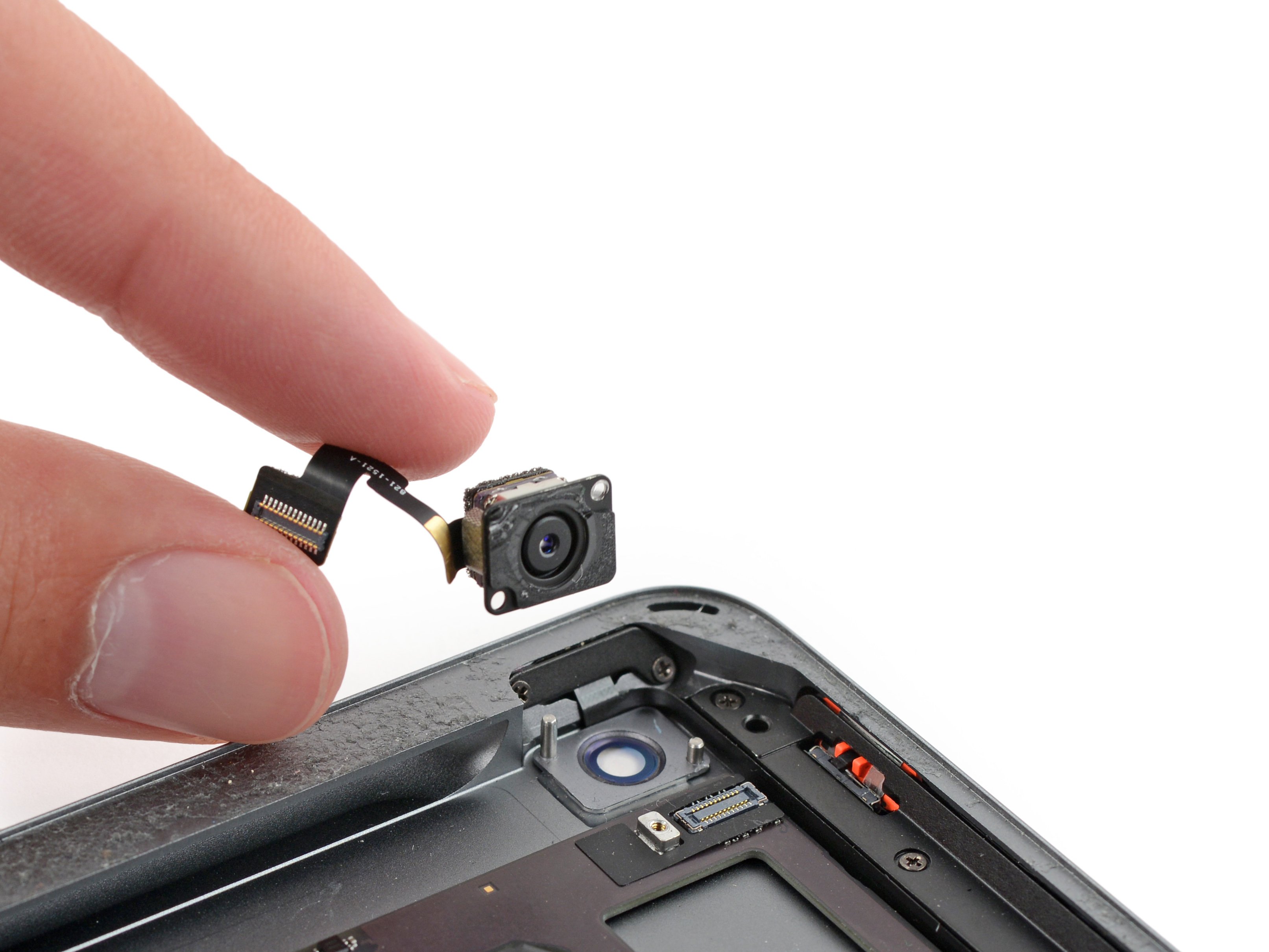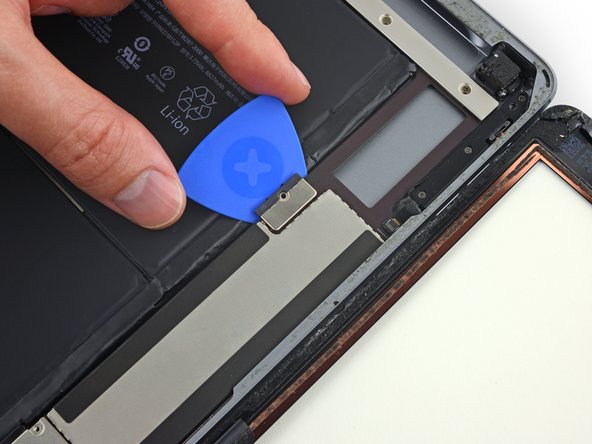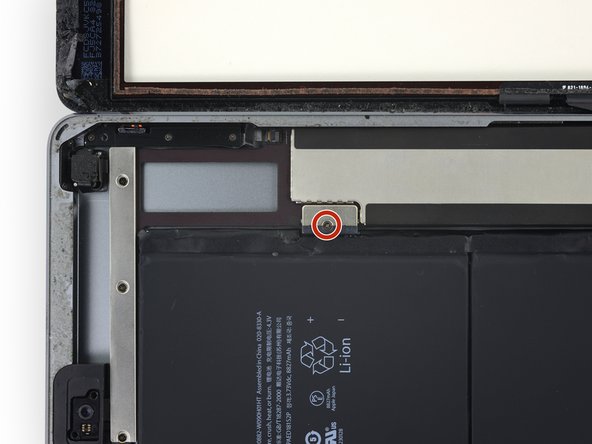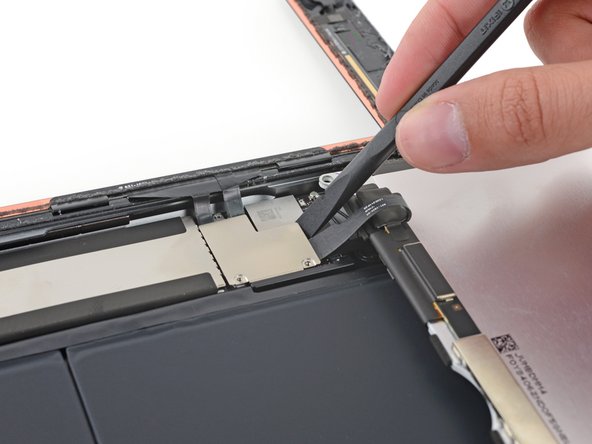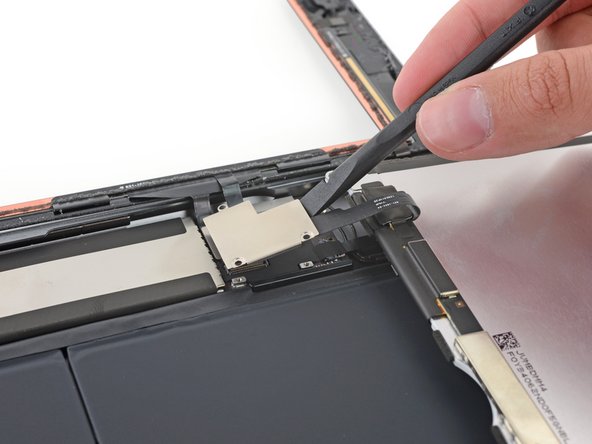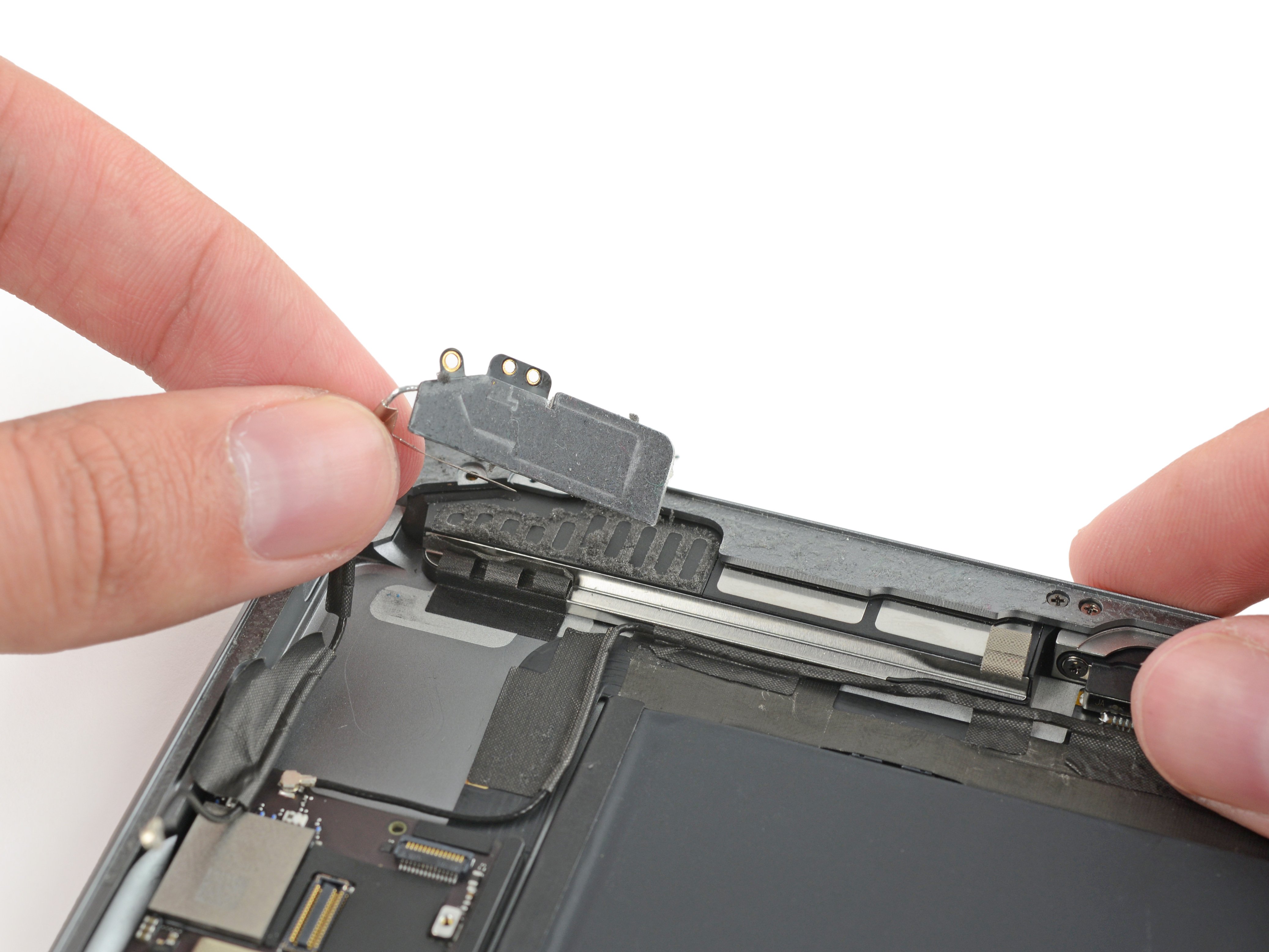iPad 5 Wi-Fi Rear Facing Camera Replacement
Duration: 45 minutes
Steps: 44 Steps
Handle with care while you work on isolating the battery using a battery blocker!
Get ready to swap out that rear-facing main camera on your iPad 5 Wi-Fi! Just a heads up, when you're isolating the battery with a battery blocker, take it easy—those battery contacts are a bit fragile and can cause some serious trouble for the logic board if damaged. If you decide to skip isolating the battery, try to keep metal tools to a minimum (only use them when absolutely necessary, like for screws) to avoid any unexpected battery shorts or mishaps with the delicate circuit components. If you find yourself in a pickle, don't hesitate to schedule a repair!
Step 1
- Warm up an iOpener and chill it on the left edge of the device for a solid two minutes.
Tools Used
Step 2
- As you let that adhesive work its magic, keep an eye out for these sensitive spots that prefer a gentle touch:
- Front camera
- Antennas
- Display cables
Step 3
The upcoming three steps walk you through the Anti-Clamp, a handy tool designed to make prying open your device a breeze. If you’re not using the Anti-Clamp, just skip ahead three steps for another way to get it done.
For detailed instructions on how to work the Anti-Clamp like a pro, check out this guide.
If your iPad’s surface is feeling a bit too slick for the Anti-Clamp to grip, stick on some tape to give it a better hold.
- Slide the blue handle back to release the Anti-Clamp's arms.
- Set your iPad on something so it sits nice and flat between the suction cups.
- Place the suction cups near the middle of the left edge—one towards the top, the other near the bottom.
- Keep the bottom of the Anti-Clamp steady while pressing down firmly on the top cup to get a good seal.
Step 4
- Give that blue handle a little tug forward to lock those arms in place! You've got this!
- Now, twist that handle clockwise all the way around - that's a 360-degree spin! Keep going until those suction cups start to stretch a bit.
- Just a friendly reminder: make sure those suction cups are staying in sync with each other. If they start to wobble out of line, don't sweat it! Just loosen them up a tad and get those arms back on track.
Step 5
Turn no more than half a twist at a time, then take a chill minute to let the Anti-Clamp and patience do their magic.
For a full walkthrough on how to operate a hair dryer, take a peek at this guide.
If the Anti-Clamp isn’t opening up enough, heat things up a bit more and twist the handle clockwise about half a turn.
- Hold tight for a minute to let the adhesive loosen up and create a nice little gap to work with.
- If the screen isn’t warming up enough, grab a hair dryer and gently heat along the left edge of the iPad.
- Once the Anti-Clamp opens up a good gap, slide an opening pick under the digitizer to get things started.
- Go ahead and skip the next step.
Step 6
If your screen is shattered like a jigsaw puzzle, slapping on some clear packing tape might just do the trick to help your suction cup stick! If that's not your vibe, a sturdy tape can be your trusty sidekick in place of the suction cup. And if you're really in a bind, a little superglue can temporarily unite the suction cup with your cracked screen for a quick fix.
- Once the screen feels warm to the touch, grab a suction handle and stick it as close to the left edge as you can.
- Gently lift the screen with the suction handle to create just enough space between the digitizer and the frame.
- Slide an opening pick into that little gap you’ve made, and you're all set to go!
Tools Used
Step 7
No need to fret if you spot the opening pick peeking through the digitizer — just gently pull it out. Your LCD screen should be just fine, but be aware that you might leave some sticky adhesive behind that's a bit tricky to clean up.
- Pop in a second opening pick right into that gap you've just opened up.
- Gently slide the pick over to the bottom-left corner of your device to break free from that sticky adhesive.
- Keep that pick snug in the bottom-left corner to stop the adhesive from going back to its old ways.
Step 8
- If your opening pick decides to play sticky and gets caught in the adhesive, just give it a smooth little roll along the edge of the iPad to keep that adhesive separation moving.
Step 9
- Gently slide that first opening pick towards the top-left corner of your device to break the adhesive free.
- Once you’ve made that move, leave the pick wedged in the top-left corner to keep the adhesive from sticking back together.
Step 10
- Warm up an iOpener and chill it right on the top edge of your device for a solid two minutes.
Tools Used
Step 11
- Gently twist the pick around the top-left corner of your device to break free that stubborn adhesive.
Step 12
Be careful not to slide the pick over the front camera, as that could lead to some lens mishaps. Follow these steps to keep everything safe and sound!
- Gently slide the opening pick along the top edge of your device, stopping just shy of the front camera. Patience here goes a long way—don't rush it!
Step 13
- Gently pull the pick out until just the tip is tucked between the digitizer and the frame.
- Carefully slide the pick over the front camera area to loosen the adhesive.
- Rest the pick near the right side of the front camera before moving on to the next step.
Step 14
- Pop that pick back in and gently slide it over to the top-right corner of your device to fully break free from the adhesive's grip.
- Keep the pick snug in the top-right corner to stop that pesky adhesive from sticking back together!
Step 15
- Warm up your iOpener and give that right edge of your device a cozy two-minute hug.
Tools Used
Step 16
- Gently twist the pick around the top-right corner to break through the adhesive seal like a pro.
Step 17
The display cables hang out around the halfway point from the bottom of the iPad. Once you slide in about three inches from the bottom, it's time to stop - you don't want to go too far, trust us!
- Grab a fresh opening pick and slide it smoothly into the middle of the iPad’s right edge.
Step 18
- Warm up an iOpener and press it against the bottom edge of your device for a solid two minutes.
Tools Used
Step 19
Avoid spinning the pick all the way around the corner to keep the antenna safe and sound.
- Gently slide the bottom-left pick down to the corner to loosen up that stubborn adhesive.
- Keep the pick nestled in the bottom-left corner before moving on to the next step.
Step 20
Be sure to slide the pick gently toward the home button, not away from it; doing otherwise might cause some antenna trouble. Keep it cool and steady!
If you find yourself needing to glide the pick over this spot again, just pull it out and pop it back in at the bottom-left corner.
- Gently slide a new opening pick into the gap you just made along the bottom edge of the iPad.
- Carefully glide the pick over the antenna, stopping right before you reach the home button.
- Let the pick rest to the left side of the home button before moving on to the next step.
Step 21
Be sure to only slide the pick in just 1 mm to keep that right antenna safe and sound!
- Gently slide an opening pick into the gap you just made.
- Carefully work the pick under the home button, inching it towards the bottom-right corner, making sure only the tip is sneaking between the digitizer and the frame.
Step 22
Slide the pick gently toward the home button only—going the other way might mess up the antenna, and we don't want that!
If you need to glide the pick over this spot again, just pull it out and pop it back in at the bottom-right corner to keep things smooth.
- Slide the pick back in and gently work it toward the home button to fully loosen that stubborn bottom adhesive.
- Set the pick just to the right of the home button and hold tight before moving on.
Step 23
- Heat up your iOpener and gently place it on the right edge of your device for about two minutes. Let the warmth work its magic, softening things up nicely.
Tools Used
Step 24
Take it slow and steady here! Warm up that adhesive until it's nice and soft, gently work your pick to separate everything, and remember—it's totally fine to pause and reheat if you need.
If you hit some stubborn resistance, just warm up the edges a bit more and gently wiggle an opening pick along them.
- Gently twist the two opening picks at the left corners of the iPad to carefully lift the digitizer, loosening the last bits of adhesive holding it down.
Step 25
- Gently lift the left edge of the digitizer and let it rise a bit to help loosen that pesky adhesive along the right edge of the iPad. You're doing great!
Step 26
- While gently holding the digitizer, use an opening pick to slide between the display cables. This will help you separate the final bit of adhesive, making the process smoother. Keep it steady, you're almost there!
Step 27
- After you’ve carefully separated all the adhesive, gently open the digitizer like a book and lay it flat next to the iPad.
- When putting things back together, wipe away any leftover adhesive from the frame—and the digitizer if you’re reusing it—using some isopropyl alcohol. Then swap in fresh adhesive strips or pre-cut adhesive cards to keep everything snug.
- Keep an eye on those display cables during reassembly. Make sure they’re neatly folded under the LCD screen to avoid any accidental damage.
Step 28
- Peel back any tape that's hiding the LCD screws so you can get to them.
Step 29
- Let's get this party started by unscrewing those pesky Phillips screws holding the LCD in place! You'll need to take out three 4.0 mm screws and one 4.8 mm screw. You've got this!
Step 30
Don't try to yank the LCD off completely just yet—it’s still hanging on by a few cables near the home button. Start lifting gently from the front-facing camera side instead.
Take it slow and watch those LCD cables like a hawk as you flip the display over.
Carefully place the LCD on a soft, clean, lint-free spot to keep it safe and sound.
- Gently wedge the flat end of a spudger under the LCD just enough to lift it out of its groove so you can get a good grip with your fingers.
- Carefully flip the iPad LCD over like turning a page, starting near the camera and folding it back over the home button side of the rear case.
- Set the LCD face down to give yourself easy access to the display cables.
Tools Used
Step 31
Handle the battery with care when using a battery blocker! Those contacts can be fragile, and a little mishap could lead to some serious damage. Stay sharp and take it easy!
Want to keep those pesky shorts at bay? Slip in a battery blocker or grab a modified opening pick to help disconnect that battery like a pro!
If you're having a little trouble getting that battery blocker under the logic board, a trusty playing card can work wonders to help you out!
- Unscrew the lone 2.3 mm Phillips screw holding the battery connector onto the logic board.
- Slide the battery blocker right under the battery connector area on the logic board and keep it there while you continue working.
Tools Used
Step 32
- Unscrew the three 1.4 mm Phillips screws holding down the display cable bracket—time to free that cable!
Step 33
Be careful with the display cable connector! It's snugly attached to the underside of the bracket, so when you're using the spudger, keep it gentle and don't go too deep under the bracket. We wouldn't want you to accidentally give that connector a rough time!
- Grab your trusty spudger and gently slide the flat end under the display cable bracket. With a little finesse, lift it straight up from the logic board like a pro!
Tools Used
Step 34
- Take off the LCD screen with care.
Step 35
- Peel away any tape that's holding down the home button ribbon cable connector. Time to set that little guy free!
Step 36
- Grab your trusty spudger and gently use its flat end to lift that tab on the home button ribbon cable ZIF connector. You're doing great!
- Now, with a delicate touch, slide the home button ribbon cable out of the ZIF connector horizontally. Easy peasy!
Tools Used
Step 37
Be gentle and only pry on the connectors themselves—avoid nudging the socket on the logic board to keep your iPad safe and sound.
- Carefully use the flat end of a spudger or your fingernail to gently lift the two digitizer cable connectors straight up from their sockets.
Tools Used
Step 38
- Gently lift the home button ribbon cable away from the adhesive that's holding it to the rear case. Take it slow, no need to rush—this part is all about being precise!
Step 39
The insulation is a sneaky little thing—it's not something you can see with your own eyes! And just to clear things up, it's not the same as those foam dust barrier strips you might find on many iPads.
- Take off the front panel assembly carefully.
- When putting it back together, give the inside of the front panel assembly a good wipe to clear away any dust or fingerprints so your display looks spotless.
- If your new display starts acting up with 'ghost' or 'phantom' touch inputs, a simple fix is to add a super thin layer of insulating tape, like Kapton (polyimide) tape, on the highlighted spots on the back of the panel. Panels from Salvation Repair already come insulated properly, so you probably won’t need to add any tape.
- Without this insulation, certain parts of the digitizer might accidentally touch other components, causing those pesky touch glitches.
Step 40
- Unscrew the three 1.4 mm Phillips #000 screws that are holding down the upper component cable bracket. Let's get that bracket out of the way!
Step 41
If you're working with the Wi-Fi/Cellular model, your iPad might look a little different. You'll need to remove two extra screws to get to some components hidden behind this bracket. No biggie—just a little extra step to make sure everything's running smoothly!
- Detach the upper component cable bracket with care.
Step 42
Be gentle and lift the connector, not the socket itself. It's all about that delicate touch!
- Gently use the flat end of a spudger to unplug the rear-facing camera connector from the logic board.
- Slide the rear-facing camera cable to the left to move it out of your way.
Tools Used
Step 43
- Slide a plastic opening tool under the rear-facing camera, gently pry it up, and lift it away from the sticky adhesive that's holding it to the back case.
Step 44
- Carefully detach the rear camera from the device.
